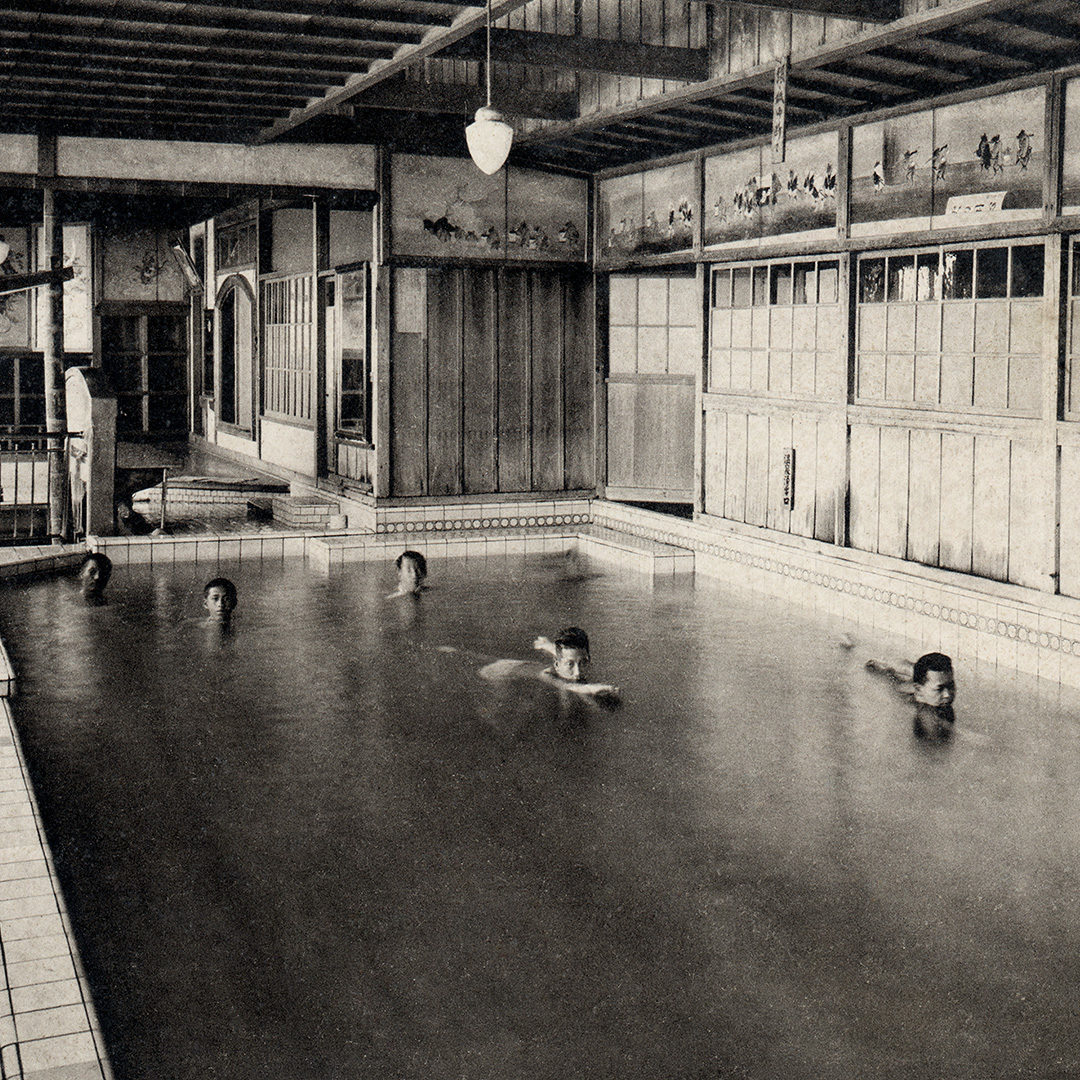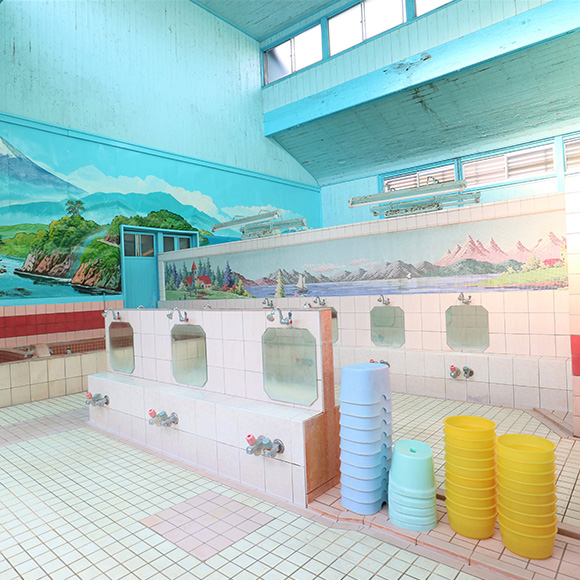
Steam Dreams: The Japanese Public Bath
Exhibition
February 12 – May 22, 2021
Steam Dreams: The Japanese Public Bath plunges into the world of sentō—the history of the public bath, the importance of its preservation and the future of Japanese communal bathing culture. Through a diverse selection of works including historical artefacts, retro-pop ephemera, mural painting, contemporary photography, illustration, and local community art, Steam Dreams presents an introduction to the multifaceted sentō culture of Japan.
Steam Dreams features commissioned works by Mizuki Tanaka and Toshizō Hirose, architectural illustrations by Honami Enya, historical photographs of sentō by Kimbei Kusakabe and others, as well as contemporary photographs by Kōtaro Imada, and sentō artefacts from the Mosaic Tile Museum, Tajimi. The exhibition also presents community art from the active sentō establishment Katsura-yu and various archival objects retrieved from Japanese public bathhouses from Bunkyo Youth Society of Architecture.
Curated by Eloise Rapp and Simonne Goran, this exhibition gives attendees the unique chance to appreciate the progression of Japanese bath culture from over 150 years ago until now by tracing the distinct bathing practices of Meiji and Shōwa-periods such as design transitions from wooden floors to tiled interiors, the implemented gender division, and the connection back to nature through mural artistry.
An event program featuring film screenings, workshops and a catalogue launch will run in conjunction with the exhibition. On Saturday, March 20 the gallery will be open until 7pm as part of the Art Month Sydney Chippendale and Redfern Art at Night walking tour.
Exhibiting Artists
 Honami Enya is an illustrator and the manager (bantō) of Kosugi-yu, a sentō in Kōenji, Tokyo. After completing an architecture degree at Waseda University Graduate School, Enya worked in a well-known architectural firm, the workload of which caused her health to deteriorate. Enya was saved by the sentō she began to visit while in temporary retirement, which led to her deciding to share her sentō illustrations, entitled Sentō Diagrams, on social networking sites. These illustrations became so popular that Kosugi-yu reached out to offer her the position of bantō.
Honami Enya is an illustrator and the manager (bantō) of Kosugi-yu, a sentō in Kōenji, Tokyo. After completing an architecture degree at Waseda University Graduate School, Enya worked in a well-known architectural firm, the workload of which caused her health to deteriorate. Enya was saved by the sentō she began to visit while in temporary retirement, which led to her deciding to share her sentō illustrations, entitled Sentō Diagrams, on social networking sites. These illustrations became so popular that Kosugi-yu reached out to offer her the position of bantō.
 While attending Meiji Gakuin University, Mizuki Tanaka apprenticed under master sentō artist Morio Nakajima. Since 2013, Tanaka has been creating sentō murals with her husband Yoshikazu Komamura through his company Handyman Komamura. Tanaka has done mural pieces for corporations such as Audi Japan and BEAMS, and her exhibition history includes Mizuki Tanaka Sentō Mural Exhibition (Matsudai Nohbutai, 2014), Echigo-Tsumari Art Triennale Selected 100 Marginal Arts of Today (Matsudai Nohbutai Centre, Niigata, 2015), and more.
While attending Meiji Gakuin University, Mizuki Tanaka apprenticed under master sentō artist Morio Nakajima. Since 2013, Tanaka has been creating sentō murals with her husband Yoshikazu Komamura through his company Handyman Komamura. Tanaka has done mural pieces for corporations such as Audi Japan and BEAMS, and her exhibition history includes Mizuki Tanaka Sentō Mural Exhibition (Matsudai Nohbutai, 2014), Echigo-Tsumari Art Triennale Selected 100 Marginal Arts of Today (Matsudai Nohbutai Centre, Niigata, 2015), and more.
 Kōtaro Imada graduated from the Nippon Photography Institute and in 2005 apprenticed under Yoshinori Komatsu and worked on taking photographs for home builder advertisements. In 2006 he began to take photos using sentō as his main subject. Two years after that, Imada joined the Kawasumi Architecture Photograph Office. In 2014 he became a freelance photographer, and inherited the trade name of his father’s studio. While currently based in Tokyo, Kantō, he takes architectural photographs throughout the whole of Japan.
Kōtaro Imada graduated from the Nippon Photography Institute and in 2005 apprenticed under Yoshinori Komatsu and worked on taking photographs for home builder advertisements. In 2006 he began to take photos using sentō as his main subject. Two years after that, Imada joined the Kawasumi Architecture Photograph Office. In 2014 he became a freelance photographer, and inherited the trade name of his father’s studio. While currently based in Tokyo, Kantō, he takes architectural photographs throughout the whole of Japan.
 Toshizō Hirose is originally from Yokohama city in Kanagawa prefecture. Though he was once a programmer, in 2015 he became a freelance sentō hanko designer, which he still does today. Since June 2014 he has had an ongoing column in sentō newspapers around Japan entitled Tales of Sentō Hanko Art. As of January 2021 he has completed hanko for 250 bathhouses (111 of which are situated in Tokyo).
Toshizō Hirose is originally from Yokohama city in Kanagawa prefecture. Though he was once a programmer, in 2015 he became a freelance sentō hanko designer, which he still does today. Since June 2014 he has had an ongoing column in sentō newspapers around Japan entitled Tales of Sentō Hanko Art. As of January 2021 he has completed hanko for 250 bathhouses (111 of which are situated in Tokyo).
Featuring contributions from the following organisations, institutions and collections
Mosaic Tile Museum, Tajimi is located in the town of Kasahara, Tajimi city. Following years of preparation led by organisations representing the local mosaic tile industry, which boasts the country’s largest production volume of mosaic tiles, the museum opened in 2016 and houses over 10,000 artifacts and other materials. The collection includes tile sample books/boards and tile products from the past, such as wash basins, bathtubs, and export goods, as well as tools and utensils formerly in use. In addition to exhibiting objects and materials, the museum hopes to play a unique role in connecting people from diverse backgrounds through the medium of tile, leveraging its location in the heart of one of the country’s foremost tile-producing locales.
Bunkyo Youth Society of Architecture was founded in 2011 as a volunteer organisation for young people, specialising in the city and architecture related to the Bunkyo ward in Tokyo. They rediscover the overlooked charms of the region from an architectural point of view, and share their values by promoting the appeal and new modes of engaging with sentō through various channels. Since 2012, they have been shining a spotlight on sentō, a local community hub, and have toured an exhibition entitled Sentō: Your Local Luxury Space, a research project on 11 active sentō in Bunkyo ward. At the same time, they also gather records of sentō when they close down, hold summits to support sentō, conduct seismic evaluations of aging sentō, and propose plans for the restoration and alternative use of sentō that are still in business.
Katsura-Yu was established in 1929, with the goal of being a sentō with strong, vibrant roots in the local area. We focus on improved health, mutual interaction, and improved welfare for our customers, and we strive to be a place where they feel able to relax both body and soul. In addition, we have inherited good old-fashioned traditions, whilst carrying out new endeavours and initiatives that follow more modern trends, and we work to make the region of Katsura in Kyoto more active.
Duits is a boutique journalism and photography agency in Tokyo with an extensive archive of authentic images of old Japan. On display in the exhibition are reproduced images of sentō and onsen that depict the evolution of the public bath from the late 1800s through to the mid-1900s.
EXHIBITION DETAILS
OPENING RECEPTION
February 12, 2021 (Friday)
6pm-8pm
Opening address at 6:30pm
Bookings required
GALLERY HOURS
Mon–Fri: 10am–6pm
Sat: 10am–4pm
Closed on May 21 (Friday) from 10:30-11:30am for a private event.
Extended hours on Saturday, March 20 for
Art Month Sydney: 3pm–7pmCancelled due to inclement weather
Closed on Sundays, April 2-6, April 25
VENUE
The Japan Foundation, Sydney
Level 4, Central Park
28 Broadway, Chippendale NSW 2008
ADMISSION
Free
ENQUIRIES
(02) 8239 0055
Header image: Kimbei Kusakabe, Women in Bath, c. 1890s. © Kjeld Duits Collection









